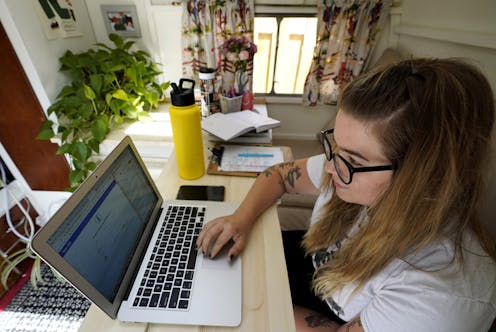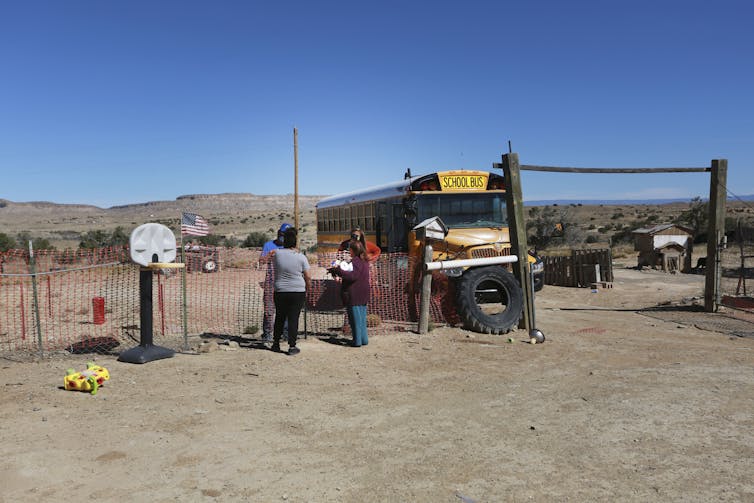State efforts to close the K-12 digital divide may come up short
- Written by Stephanie Holcomb, Ph.D. Student in Planning and Public Policy, Rutgers University
 Students and teachers alike struggle with digital connectivity – but education is just one area in which technology matters.AP Photo/Nam Y. Huh
Students and teachers alike struggle with digital connectivity – but education is just one area in which technology matters.AP Photo/Nam Y. HuhIn 2021, New Jersey Gov. Phil Murphy announced that education officials in his state had “closed” the digital divide by ensuring that every public school student had a laptop or tablet and internet access.
“Closing the digital divide wasn’t just about meeting the challenges of remote learning,” Murphy, a Democrat, said at the time. “It’s been about ensuring every student has the tools they need to excel in a 21st century educational environment.”
While the Murphy administration was successful in giving 358,212 students access to critical education tools they previously lacked, the digital divide remains a problem in New Jersey as well as throughout the nation.
Federal data
A U.S. Census Bureau survey undertaken during the pandemic found that not all families with school-age kids had internet access or computers. The levels varied by race and family income.
For instance, whereas 84% of Asian families said they always had a computer on hand for educational uses, only 72% of Hispanic or Latino families did.
And 87% of Asian families said they always had internet access available for school-related activities. But just 68% of families that were biracial, multiracial or in a group labeled “other races” – meaning not white, not Black, not Asian and not Hispanic or Latino – said the same.
Families with higher incomes were more likely to have both internet access and digital devices always available for education. But even the highest-income households didn’t have 100% availability of either. And only about two-thirds of families with incomes below $35,000 did.
State and local efforts
Different communities took different approaches to handling the digital divide before and during the pandemic. A National Governors Association review showed that some education leaders sought to address the immediate needs of students, such as access to computers at home, while others explored long-term broadband solutions.
Some states partnered with internet service providers or nonprofit organizations with a specific focus on digital access or inclusion, or other organizations with broader missions, such as local libraries.
In Philadelphia, the city worked with the school district, foundations and local cable providers to make sure all public school students have access to free and reliable internet at home. Chicago did something similar.
In October 2021, New York City announced an initiative to build a publicly owned, open-access broadband system to provide affordable internet access across the city.
Partnerships like this have resulted in the delivery of mobile hot spots, free internet subscriptions and digital literacy courses. Other local efforts, including from municipal governments and nonprofit organizations, sought to improve public Wi-Fi service and get computers or tablets to people who needed them.
A lasting problem
A 2021 report from New America and Rutgers University shows that, while internet access has greatly increased since 2015, 1 in 7 children still do not have high-speed internet access at home.
One reason for this may be the focus on temporary solutions to deeper social issues. A device and hot spot issued for one year does not permanently address problems as complex as the digital divide.
Another factor may be the ability to identify those in need. New Jersey’s survey didn’t ask families about their devices and connectivity. Instead, state officials asked local school districts and took their word without double-checking their reported results.
At the federal level, similar attempts to measure the digital divide have also come up short, overestimating the numbers of people who have a computer and internet service. The Federal Communications Commission has also overstated the degree to which high-speed service is available to internet customers.
 Many rural students don’t have any internet service available, and many urban students’ families can’t afford it.AP Photo/Cedar Attanasio
Many rural students don’t have any internet service available, and many urban students’ families can’t afford it.AP Photo/Cedar AttanasioFederal funding
The federal infrastructure package seeks to tackle the digital divide more directly than ever before in the U.S. The law’s text says high-speed internet access is as essential as running water and electricity to “full participation in modern life in the United States.” The package included US$2.75 billion to fund an effort to improve online accessibility for social services.
Whether the equitable delivery of digital access is achieved will depend on implementation. Studies of national broadband efforts in Australia and India show it isn’t always easy. They also find that the programs don’t make up for existing social inequities. For instance, in Australia, poorer communities got worse internet service than wealthier places. In the U.S., past broadband initiatives have not provided equitable service.
The infrastructure law has the potential to ensure that digital access becomes a higher government priority. But experience shows fully closing the digital divide will require much more.
Jessica Cruz, a Rutgers master’s student in public informatics, contributed to this article.
[Like what you’ve read? Want more?Sign up for The Conversation’s daily newsletter.]
Stephanie Holcomb is a researcher with organizations that receive funding from the State of New Jersey, federal agencies, and several foundations including the Robert Wood Johnson Foundation.
Andrea Hetling receives funding from the US Department of Health and Human Services Administration for Children and Families, the Robert Wood Johnson Foundation, the New Jersey Office of the Secretary of Higher Education, and the New Jersey Department of Human Services Division of Family Development.
Gregory Porumbescu receives funding from the New Jersey Office of the Secretary of Higher Education and the National Science Foundation.
Vishal Trehan does not work for, consult, own shares in or receive funding from any company or organisation that would benefit from this article, and has disclosed no relevant affiliations beyond their academic appointment.
Authors: Stephanie Holcomb, Ph.D. Student in Planning and Public Policy, Rutgers University
Read more https://theconversation.com/state-efforts-to-close-the-k-12-digital-divide-may-come-up-short-173977

